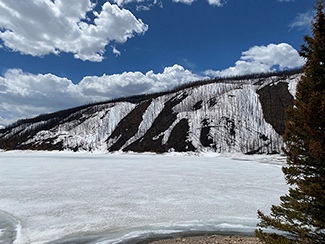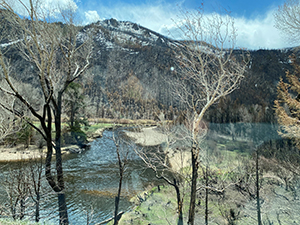Greeley’s drinking water is sourced from mountain snowpack and a multitude of mountain reservoirs. Water is collected from west slope lakes, the Big Thompson River and the Cache la Poudre River.  Water from the Cache la Poudre is diverted into the city’s Bellvue Water Treatment plant at the mouth of the Poudre Canyon for treatment before it is delivered to Greeley customers. But 2020forest fires damaged vast areas our watersheds, creating risk of flooding, sedimentation of reservoirs and water quality challenges for treatment facilities.
Water from the Cache la Poudre is diverted into the city’s Bellvue Water Treatment plant at the mouth of the Poudre Canyon for treatment before it is delivered to Greeley customers. But 2020forest fires damaged vast areas our watersheds, creating risk of flooding, sedimentation of reservoirs and water quality challenges for treatment facilities.
Fires not only burn the trees and damage infrastructure at the outset, they impair ecosystem functions, and fire leaves a lot of debris, sediment and ash in the wake, increasing the potential of flooding, erosion in our main sources of drinking water.
“During active burning, ash and contaminants associated with ash settle on streams, lakes and water reservoirs,” reports the Environmental Protection Agency. “Vegetation that holds soil in place and retains water is burned away. In the aftermath of a large wildfire, rainstorms flush vast quantities of ash, sediment, nutrients and contaminants into streams, rivers, and downstream reservoirs. The absence of vegetation in the watershed can create conditions conducive to erosion and even flooding, and naturally occurring and anthropogenic substances can impact drinking water quality, discolor recreational waters, and may potentially contribute to harmful algal blooms.”
Greeley’s water system is uniquely diverse in that the city has several sources of water, but there was fire in all four of Greeley’s watersheds in 2020. Severely burned watersheds translate into sediment and ash in the sourcewater that must be removed through water treatment. When water turbidity (cloudiness) is at its highest, the city can bypass and use another source of water.
The city of Greeley takes is duty to provide safe reliable water very seriously and is working with the city of Fort Collins and Larimer County in cost and work-sharing agreement to mitigate fire damage and stabilize hillslopes, build erosion controls, stabilize stream channels, and protect infrastructure in the Cameron Peak Fire burn area. Without this work, infrastructure will be at risk and the costs to treat water for municipalities will skyrocket.
The cost for mitigating the watershed’s most urgent needs exceeds $40 million, and Greeley and its partners have been pursuing state and federal funding and support for the emergency post fire recovery. Federal officials toured the burn area on May 7, after touring the East Troublesome fire earlier in the week, to witness what the cities are up against. Officials from Greeley, Fort Collins, Larimer County, and northern Colorado water districts hosted USDA Secretary of Agriculture Tom Vilsack, U.S. Sens. Joe Neguse and Michael Bennet, and Gov. Jared Polis on a tour of the burn scar. “The wildfire recovery sponsors, including Greeley, have significant urgent needs for funding to support the watershed mitigation” said Sean Chamber, Director of Water & Sewer. That funding may come in the form of 2021 Emergency Supplemental Appropriation for recovery programs under the US Dept. of Agriculture, and that could complement other state grants to allow the cities a jump start on watershed recovery.
“We’re going to work closely with Sen. Bennet in effort to make sure we have the resources to do the job and do it well,” Vilsack told the tour group. In the future, federal officials say they want to be more on the offensive with fires, eliminating fuel sources, as an example, to reduce overall costs. That involves thinning, timber harvesting, prescribed burning, or a combination of these, and it doesn’t come cheap.